
Finding better ways to help workers keep their eyes on the prize—whether it’s monitoring key performance indicators (KPIs) for productivity and quality or detecting the reason for a fault in a machine’s performance—is leading to the development of increasingly sophisticated visualization tools for human-machine interfaces (HMIs) and supervisory control and data acquisition (SCADA) applications.
The key goals are threefold: enable mobility, so workers can see what’s happening on whatever screen they’re using, whether standard HMI hardware, smartphone or tablet; provide context beyond the machine level to support data interpretation and decision-making; and empower workers to take action from wherever they are, enabling them to respond in real time even from remote locations.
What many of the latest products have in common is the use of web technologies that are tearing down the proprietary walls that have long created barriers within and between industrial systems. With interfaces that are more intuitive—and more similar to their personal technologies—operators find the tools are easier to use and require less training.
As is happening around industry, particularly in IT-facing scenarios, consumer experiences are setting the template for what workers expect from their industrial visualization systems. “I can track my Uber car on my phone. I can search on anything in Google. I can do anything in a web browser. I can do anything on my mobile device. I can share docs in real time in Google. Websites recommend things for me based on what I do,” notes Michael Risse, chief marketing officer atSeeq. “All of these consumer experiences become expectations for the applications that people use at work.”
Seeq has incorporated this level of experience into its Seeq Workbench. “So [users can] search [it] like Google, work in a web browser, work in real time with colleagues, do complex calculations, interact with data at the speed of thought, predict outcomes, cleanse the data,” Risse says.
Seeq Organizer enables the distribution of time-relative analyses to others in a way that lets the recipient get directly to the underlying data, Risse adds. “So we don’t call them reports because they are not pictures of data, they are links to the data; it’s live, you’re on it, and the old decoupling of user from data is eliminated.”
提供对运营商的实时数据和分析在重要的是提供运营商的越来越多地了解他们的决策如何影响整体业务。可视化工具允许运营商在不等待主管的批准或下一个员工会议的情况下做出决策并采取行动。
This “empowerment at the edge” is changing how plants are operated, according to John Krajewski, director of project management for the HMI and SCADA portfolio atAveva, formerly part of Schneider Electric Software. “The shift to real-time decision-making,” he says, “is changing the focus of employees from operating the process to operating the business.”
Aveva has developed Insight Performance—a secure, managed-cloud platform—that enables end users and system builders to collect, visualize and analyze equipment utilization and efficiency data to drive plant performance and share best practices across the enterprise. It can be accessed with Wonderware InTouch HMI software through an HMI or mobile communication device.
“这是一个工具来把一个开放的态势感知能力rator’s attention to what’s most important. Insight Performance provides operators with intuitive KPI dashboards and real-time visibility into current downtime causes, empowering users to take immediate corrective action,” Krajewski says. “Advanced reporting and analysis capabilities, which can access equipment performance history from anywhere within the plant or the enterprise, allow continuous improvement and best practice standardization. OEMs can also use it to provide value-added services.”
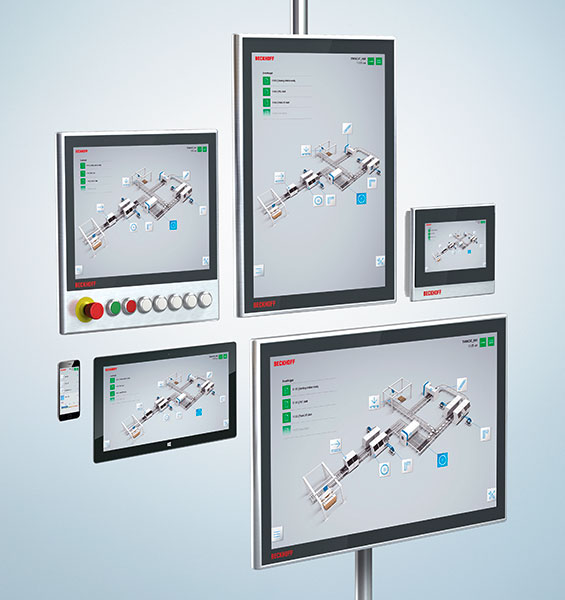 |
Beckhoff Automation’s TwinCAT HMI software platforms allows viewing on screens of any size. |
More graphics, less programming
Graphical displays that can appear on any device without programming help make information easier to understand and more actionable. This is part of what’s enabled by web-based technologies—the ability to more easily get to information from any type of device.
Beckhoff Automation新的TwinCAT HMI软件利用IT标准,例如用于设计的工程和HTML5和JavaScript等Microsoft Visual Studio,以及用于安全通信的WebSockets和HTTPS。图形编辑器配置HMI,无需编程,适应显示器以适合使用的屏幕,无论操作系统,浏览器或设备如何。
这个基本架构促进大量应用cation scenarios, from the local HMI panel to multi-client, multi-server and multi-runtime concepts. “Depending on experience and application, the HMI logic can be implemented with drag-and-drop graphical language in JavaScript or as a server extension,” explains Daymon Thompson, North American automation products manager for Beckhoff.
The company’s TwinCAT Analytics software will also receive an upgrade in mid-summer 2018 with the introduction of a graphical, drag-and-drop analytics toolbox. Part of the massive adoption of web technologies for machine visualization, this diagnostics software includes online and offline condition analysis, predictive maintenance, pattern recognition, machine optimization and long-term data archival capabilities.
“Seamless and cycle-synchronous data acquisition is a prerequisite for effective analysis and correction of processing errors in machines,” Thompson says. “Standard web technologies make products like these forward-compatible, since you never know exactly what type of device you may want to visualize data on in the future.”
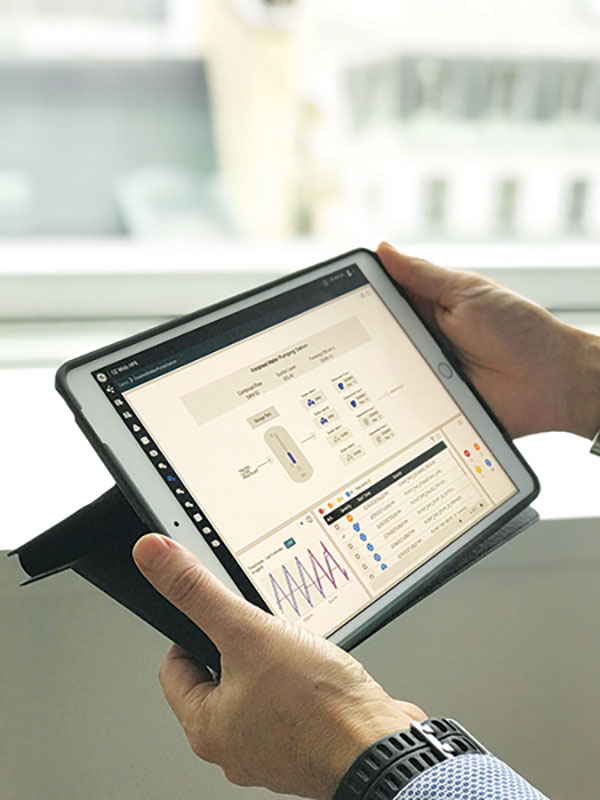 |
在平板电脑上查看GE Digital的Web HMI中创建的屏幕。 |
Visualization on any device
Today, there’s an increasing push to be able to visualize data on a mobile device of some type—smartphone, tablet, etc. Mobile technology like this has long been used in the oil and gas industry to support decision-making for field worker rounds, lock out/tag out inspection, field worker training, and alarm and event management.
Other industry segments, such as water and wastewater, food and beverage, and power, are now taking advantage of new mobile applications, allowing employees to access a software-only version of the system that they can load directly onto their own mobile devices. “This significantly reduces the barrier of entry for mobile technology in many applications,” says Matt Newton, senior portfolio marketing manager for Aveva’s asset performance management business.
“Gone are the days of operators being tied to a hardwired terminal or HMI to achieve situational awareness on asset health,” he adds. “With vendors increasing their support for mobile and web technologies like HTML5 and cloud-based platforms, operators are now able to carry around a virtual version of their plants and assets right on their mobile device, allowing them to make the right decisions at the right time, regardless of their location.”
Cloud-based systems that connect workers in real time to various enterprise systems such as enterprise asset management (EAM) are also gaining popularity with companies because they enable different business units to work together. “Visualizing KPIs, work orders, process data and other information critical to the business in real time on their mobile devices makes workers more efficient and effective,” Newton says. “Offsite experts can also better guide operators through maintenance and repair procedures, which helps keep equipment up and running and decreases unscheduled downtime.”
根据GE Digital产品自动化解决方案的副总裁Matt Wells,据Matt Wells副总裁Matt Wells表示,从设施的墙壁外面获取故障排除帮助是可视化发展的重要组成部分。“随着内部专家较少,持续成本削减,制造商现在依赖于植物外的支持,”他说。
GE Digital最近向其CIMPLICITY和IFIX HMI / SCADA软件推出了许多升级,以包括Web HMI 2.0,这是完全符合HTML5的。屏幕可以缩放到各种形状因子和方向,以便在高分辨率上进行观看。“这些启用了新的Web的HMI产品响应了这些需求,可以远程处理故障排除,无论是从工厂的另一边还是来自数百英里远的控制室,井解释说。
Web HMI 2.0 reduces development time by up to 40 percent, Wells says, by starting with a structured asset model that can then be mapped to the SCADA database. Assets need to be defined only once for each class. Pre-defined objects and templates are ready for use out of the box. A model-driven window view called Cards includes HMI, alarms, alarm summary, trends and control, and can be customized. It is compatible with Safari, Google Chrome or Microsoft Internet Explorer browsers and can be accessed for mobile operations on either an iPad or Android tablet.
“By eliminating paper and enabling mobility so that workers don’t have to move around the plant to maintain control systems, our HMI products can help improve operator consistency and performance,” Wells says.
行业也在追随消费者领先地位,如增强现实(AR)和虚拟现实(VR),以实现资产附近的改进洞察力。
“Augmented or virtual reality, when combined with other technologies such as the Industrial Internet of Things (IIoT), mobile devices, wearable technology and data analytics, will further empower operators to make informed decisions as they interact with devices in the field,” says Hayden Serio, senior engineer forMaverick Technologies. “This is an intuitive method of training, and providing information that may prove invaluable in helping to retain and transfer the operational knowledge of long-term employees to the next generation.”
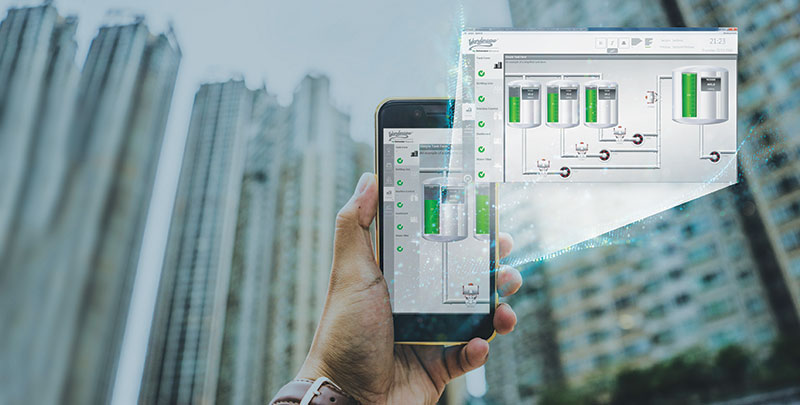 |
Aveva’s Wonderware Insight Performance dashboard lets operators visualize processes and monitor operations on mobile devices. |
硬件升级
对传统和移动屏幕格式一样,vendors continue to make hardware advances as well—making visualization possible, for example, in more hazardous or otherwise difficult environments in the field or in the factory.
TRU-VU.供应工业级LCD监视器和触摸屏的监视器发布了24英寸防水阳光可读展示,旨在直接,明亮的阳光或其他高环境光线条件运行。NEMA 4X防水,不锈钢外壳可以处理-4至158°F的工作温度。
Honeywellhas introduced a rugged handheld computer for mobile workers built on the company’s Mobility Edge Platform. The Dolphin CN80 is a hybrid device that incorporates a traditional keypad and a large touchscreen interface. It is designed for distribution centers and other field mobility applications, with options for cold storage or hazardous location environments. It can withstand multiple drops onto hard surfaces and the extended battery life supports long shifts, extended talk-times and heavy GPS use.
“For employees who work in challenging locations or who have applications that rely on keyed shortcuts to speed data entry, a physical keypad remains a popular option for capturing mission-critical information,” says Lisa London, vice president of marketing and offering management for Honeywell’s productivity products business.
A new touch-panel HMI inPhoenix Contact’s TP 3000 series supports gesturing, similar to a smartphone, that allows the user to swipe between screens. “Support of HTML5 web technology is changing the HMI operator panel landscape,” says Bjoern Falke, product manager for HMI/IPC at Phoenix Contact. “It allows a new generation of protocol-agnostic HTML5-enabled panels to easily connect to any web server, be it on a PLC, a drive or other smart automation component.”
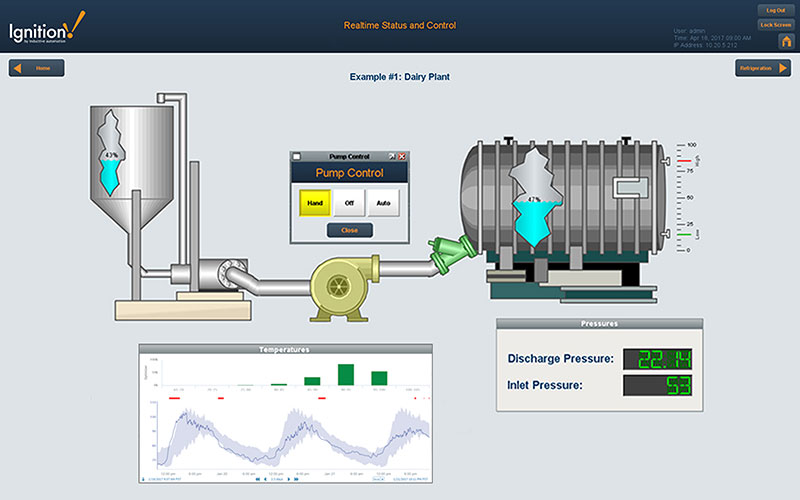 |
Seeq Workbench can be added to HMI, SCADA or DCS software. In this screen capture, it’s connected to the Ignition Vision Module from Inductive Automation. |
The data behind the curtain
What is being done with the data behind the scenes is a whole other topic of discussion. But it’s worth noting here the ability to work with the data that’s presented on the display. “Just spitting data out onto a screen is not useful,” says Sharon Billi-Duran, visualization software product manager at Rockwell Automation.
FactoryTalk Analytics for Devices is a standalone Rockwell product that sits on a network, polling devices to determine their current status and create a dashboard to display any that have an exception or error. The software’s voice-activated chatbot, known as Shelby, can be used to teach the system what information is important to an individual user, allowing the data to be customized for a device or the viewer’s functional role.
“An operator can have a targeted conversation with his or her equipment, or dig deeper if more information is needed,” Billi-Duran explains.
Separating out visualization from analytics and from advanced analytics is not always easy, Seeq’s Risse contends. “Can you just see the data, or can you manipulate it, or can you leverage recent innovations to get more out of the data than was possible in the past?” he asks. “More visualization isn’t the answer—changing the quality of the visualization experience is what’s important.”









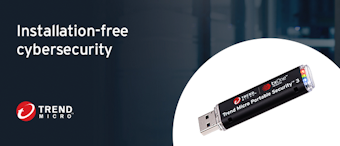










![Mps035 Sm 1200x628 D[2]](https://img.automationworld.com/files/base/pmmi/all/image/2021/03/MPS035_SM_1200x628_D_2_.604a4a336bc60.png?auto=format%2Ccompress&bg=fff&fill-color=fff&fit=fill&h=146&pad=5&q=70&w=340)













